Coplanar Asymmetry Transformer Distributed Modeling for X-Band Drive Power Amplifier Design on GaN Process
Abstract
:1. Introduction
2. Transformer Design Process Comparison
2.1. Process Parameters’ Influence to On-Chip Transformer
2.2. Transformer Design on GaN Process
2.2.1. Vertical and Coplanar Transformer’s Feature on GaN Process
2.2.2. Coplanar Transformer’s Inductance vs. Trace Width
2.2.3. w vs. s vs. k for Coplanar Transformer
3. Transformer Design and Modeling
3.1. Asymmetry Coupling Transmission Line Theory
- Obtain the S matrix of the asymmetry coupling transmission line under specific length and the frequency through EM simulation. For this transmission line coupling, the pair has four ports and the corresponding S-parameter matrix’s dimension must be 4 × 4.
- Then, transform the grasped S matrix into an ABCD matrix. Then all the parameters can be calculated through the following equations (note that A,B,C,D are 2 × 2 matrices and their elements are inherited from the transformer matrix in step 1).
- The eigenvalue decomposition on matrices A and D is applied to find the values of . , and , , , and can be found either by comparing the elements or by matrix operations on matrices B and C.
3.2. Asymmetric Coupling Transmission Line Simulation Model
3.3. Transformer Modeling Process
3.4. Comparison between the Proposed Model and Transformer Electromagnetic Simulation Results
4. Transformer Based Matching Mechanism
4.1. Proposed Distributed Transformer Output Network Design
4.2. Proposed Distributed Transformer Model for Input Network Design
4.3. Proposed Distributed Transformer Model for Interstage Network Design
4.4. Transformer Design Procedure
5. Transformer Matching Based Power Amplifier Design on GaN
6. Conclusions
Author Contributions
Funding
Conflicts of Interest
Appendix A
References
- Ma, Z.; Ma, K.; Wang, K.; Meng, F. A 28 GHz Compact 3-Way Transformer-Based Parallel-Series Doherty Power Amplifier With 20.4%/14.2% PAE at 6-/12-dB Power Back-off and 25.5 dBm PSAT in 55 nm Bulk CMOS. In Proceedings of the IEEE International Conference on Solid-State Circuits (ISSCC), San Francisco, CA, USA, 20–26 February 2022. [Google Scholar]
- Li, Y.; Yin, Y.; Zheng, D.; Jia, X.; Lin, J.; Gao, F.; Zhu, Y.; Xiong, L.; Yan, N.; Lu, Y.; et al. A 15-Bit Quadrature Digital Power Amplifier with Transformer-Based Complex-Domain Efficiency Enhancement. IEEE J. Solid-State Circuits 2022, 57, 1610–1622. [Google Scholar] [CrossRef]
- Pashaeifar, M.; de Vreede, L.C.N.; Alavi, M.S. 14.4 A 24-to-30 GHz Double-Quadrature Direct-Upconversion Transmitter with Mutual-Coupling-Resilient Series-Doherty Balanced PA for 5G MIMO Arrays. In Proceedings of the IEEE International Conference on Solid-State Circuits (ISSCC), San Francisco, CA, USA, 20–26 February 2022. [Google Scholar]
- Zhang, J.; Cheng, Y.; Zhao, C.; Wu, Y.; Kang, K. Analysis and Design of Ultra-Wideband mm-Wave Injection-Locked Frequency Dividers Using Transformer-Based High-Order Resonators. IEEE J. Solid-State Circuits 2018, 53, 2177–2189. [Google Scholar] [CrossRef]
- Wang, F.; Wang, H. A Noise Circulating Oscillator. IEEE J. Solid-State Circuits 2019, 54, 696–708. [Google Scholar] [CrossRef]
- Long, J. Monolithic transformers for silicon RF IC design. IEEE J. Solid-State Circuits 2000, 35, 1368–1382. [Google Scholar] [CrossRef]
- Chiu, T.-Y.; Wang, Y.; Wang, H. A Ka-Band Transformer-Based Switchless Bidirectional PA-LNA in 90-nm CMOS Process. In Proceedings of the Microwave, MTT-S International Symposium, Atlanta, GA, USA, 6–11 June 2021. [Google Scholar]
- Shao, H.; Qi, G.; Mak, P.I.; Martins, R.P. A 1.7–3.6GHz 20 MHz-Bandwidth Channel-Selection N-Path Pas-sive-LNA Using a Switched-Capacitor-Transformer Network Achieving 23.5 dBm OB-IIP3 and 3.4–4.8dB NF. IEEE J. Solid-State Circuits 2022, 57, 413–422. [Google Scholar] [CrossRef]
- Ju, I.; Gong, Y.; Cressler, J.D. Highly Linear High-Power 802.11ac/ax WLAN SiGe HBT Power Amplifiers with a Compact 2nd-Harmonic-Shorted Four-Way Transformer and a Thermally Compensating Dynamic Bias Circuit. IEEE J. Solid-State Circuits 2020, 55, 2356–2370. [Google Scholar] [CrossRef]
- Chowdhury, D.; Reynaert, P.; Niknejad, A. Design considerationsfor 60 GHz transformer coupled CMOS power amplifiers. IEEE J. Solid-State Circuits 2009, 44, 2733–2744. [Google Scholar] [CrossRef]
- Ma, Z.; Ma, Z.; Ma, K. A 35 dBm PSAT and 41% PAE GaAs Power Amplifier with Series Distributed-Balun. IEEE Trans. Circuits Syst. II Express Briefs 2022, 1. [Google Scholar]
- Jia, H.; Prawoto, C.C.; Chi, B.; Wang, Z.; Yue, C.P. A Full Ka-Band Power Amplifier With 32.9% PAE and 15.3-dBm Power in 65-nm CMOS. IEEE Trans. Circuits Syst. Regul. Pap. 2018, 65, 2657–2668. [Google Scholar] [CrossRef]
- Niknejad, A.M.; Meyer, R.G. Analysis, design, and optimization of spiral inductors and transformers for Si RFICs. IEEE J. Solid-State Circuits 1998, 33, 1470–1481. [Google Scholar] [CrossRef] [Green Version]
- Wang, H.; Sideris, C.; Hajimiri, A. A CMOS Broadband Power Amplifier with a Transformer-Based High-Order Output Matching Network. IEEE J. Solid-State Circuits 2010, 45, 2709–2722. [Google Scholar] [CrossRef] [Green Version]
- Ye, W.; Ma, K.; Yeo, K.S. 2.5 A 2-to-6 GHz Class-AB power amplifier with 28.4% PAE in 65 nm CMOS supporting 256 QAM. In Proceedings of the IEEE International Solid-State Circuits Conference, Digest of Technical Papers, San Francisco, CA, USA, 22–26 February 2015; pp. 1–3. [Google Scholar]
- Zhao, J.; Bassi, M.; Bevilacqua, A.; Ghilioni, A.; Mazzanti, A.; Svelto, F. A 4067 GHz power amplifier with 13 dBm PSAT and 16% PAE in 28 nm CMOS LP. IEEE J. Solid-State Circuits 2015, 50, 1618–1628. [Google Scholar]
- Hou, D.; Hong, W.; Goh, W.L.; Xiong, Y.Z.; Arasu, M.A.; He, J.; Chen, J.; Madihian, M. Distributed Modeling of Six-Port Transformer for Millimeter-Wave SiGe BiCMOS Circuits Design. IEEE Trans. Microw. Theory Tech. 2012, 60, 3728–3738. [Google Scholar] [CrossRef]
- Cheung, T.S.D.; Long, J.R. Design and Modeling of mm-Wave Monolithic Transformers. In Proceedings of the Bipolar/BiCMOS Circuits and Technology Meeting, Maastricht, The Netherlands, 8–10 October 2006; pp. 1–4. [Google Scholar]
- Wang, F.; Wang, H. A Broadband Linear Ultra-Compact mm-Wave Power Amplifier With Distributed-Balun Output Network: Analysis and Design. IEEE J. Solid-State Circuits 2021, 56, 2308–2323. [Google Scholar] [CrossRef]
- Zhu, W.; Wang, J.; Wang, R.; Zhang, J.; Li, C.; Yin, S.; Wang, Y. A 1V 32.1 dBm 92-to-102 GHz Power Amplifier with a Scalable 128-to-1 Power Combiner Achieving 15% Peak PAE in a 65 nm Bulk CMOS Process. In Proceedings of the IEEE International Solid-State Circuits Conference (ISSCC), San Francisco, CA, USA, 20–26 February 2022. [Google Scholar]
- Li, C.-H.; Kuo, C.-N.; Kuo, M.-C. A 1.2-V 5.2-mW 20–30-GHz Wideband Receiver Front-End in 0.18-µm CMOS. IEEE Trans. Microw. Theory Tech. 2012, 60, 3502–3512. [Google Scholar]
- Ye, W.; Ma, K.; Yeo, K.S.; Zou, Q. A 65 nm CMOS Power Amplifier with Peak PAE above 18.9% From 57 to 66 GHz Using Synthesized Transformer-Based Matching Network. IEEE Trans. Circuits Syst. I Regul. Pap. 2015, 62, 2533–2543. [Google Scholar] [CrossRef]
- Tsai, C.-M.; Gupta, K. A generalized model for coupled lines and its applications to two-layer planar circuits. IEEE Trans. Microw. Theory Tech. 1992, 40, 2190–2199. [Google Scholar] [CrossRef]
- Bei, S. Design and Optimization of Monolithic Spiral Transformers and Baluns. Master’s Thesis, Southeast University, Nanjing, China, 2006. [Google Scholar]
- Brink Hoff, J.; Pham, D.D.; Kang, K.; Lin, F. Anew six-port transformer modeling methodology applied to 10-dBm 60-GHz CMOS ask modulator designs. IEEE Trans. Microw. Theory Tech. 2010, 58, 297–309. [Google Scholar] [CrossRef]
- Qunaj, V.; Reynaert, P. Compact Transformer-Based Matching Structures for Ka-Band Power Amplifiers. In Proceedings of the IEEE Asia-Pacific Microwave Conference (APMC), Singapore, 1 December 2019. [Google Scholar]
- Wang, H.; Sengupta, K. RF and Mm-wave Power Generation in Silicon; Academic Press: Cambridge, MA, USA, 2015. [Google Scholar]
- Schuh, P.; Leberer, R.; Sledzik, H.; Oppermann, M.; Adelseck, B.; Brugger, H.; Quay, R.; Mikulla, M.; Weimann, G. Advanced High Power Amplifier Chain for X-Band T/R-Modules based on GaN MMICs. In Proceedings of the European Microwave Integrated Circuits Conference, Manchester, UK, 10–13 September 2006. [Google Scholar]
- Schuh, P.; Sledzik, H.; Reber, R.; Fleckenstein, A.; Leberer, R.; Oppermann, M.; Quay, R.; van Raay, F.; Seelmann-Eggebert, M.; Kiefer, R.; et al. GaN MMIC based T/R-Module Front-End for X-Band Applications. In Proceedings of the European Microwave Integrated Circuits Conference, Amsterdam, The Netherlands, 27–28 October 2008. [Google Scholar]
- Kang, L.; Chen, W.; Wu, A. A Reconfigurable S-/X-Band GaN MMIC Power Amplifier. IEEE Microw. Wirel. Compon. Lett. 2022, 32, 547–550. [Google Scholar] [CrossRef]
- Kim, D.; Lee, D.-H.; Sim, S.; Jeon, L.; Hong, S. An X-Band Switchless Bidirectional GaN MMIC Amplifier for Phased Array Systems. IEEE Microw. Wirel. Compon. Lett. 2014, 24, 878–880. [Google Scholar] [CrossRef]
- Xie, C.; Wu, P.; Tan, C.; Yuan, Y.; Zeng, J.; Yu, Z. An X/Ku Dual-Band Switchless Frequency Reconfigurable GaAs Power Amplifier. IEEE Microw. Wirel. Compon. Lett. 2022, 32, 539–542. [Google Scholar] [CrossRef]
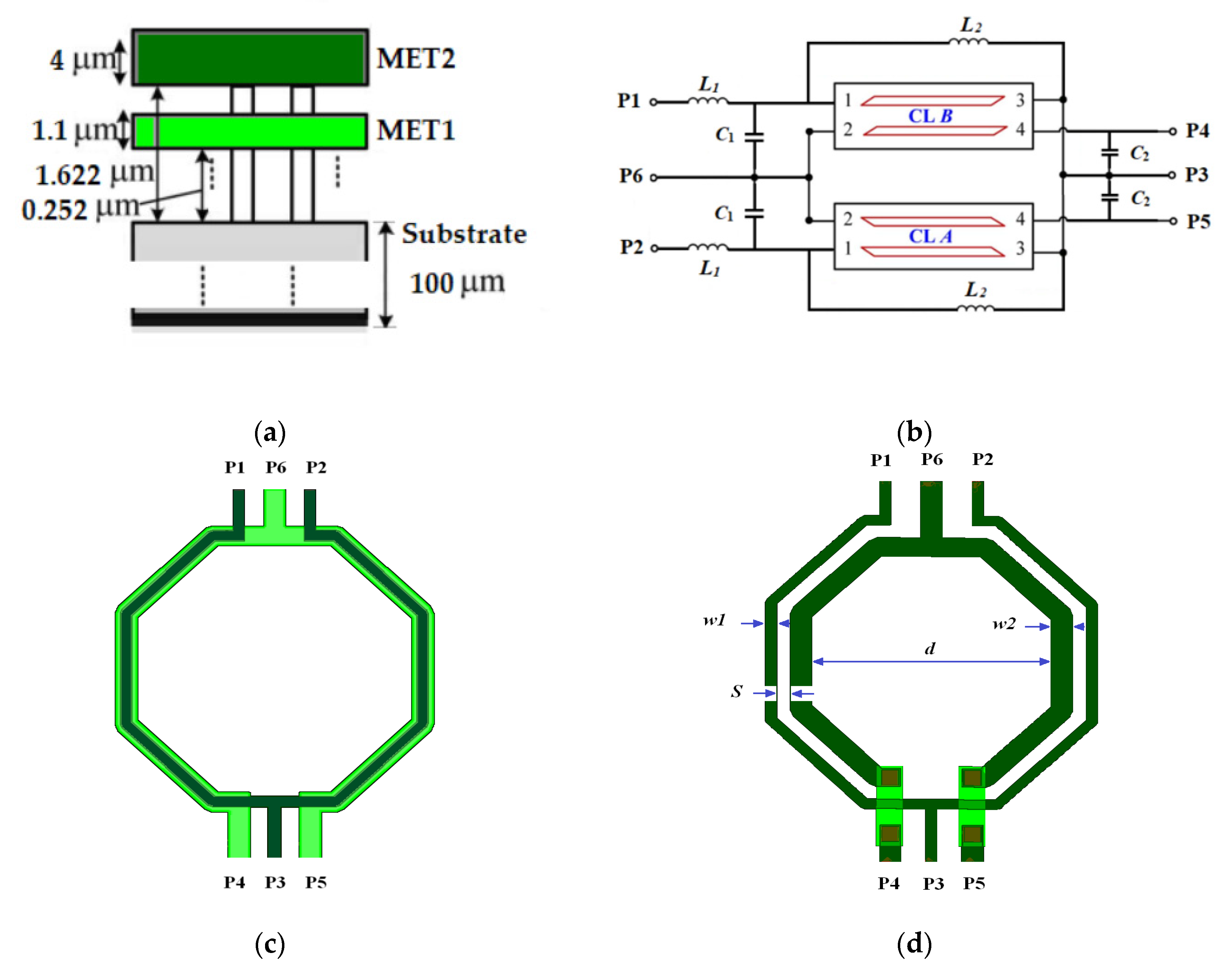
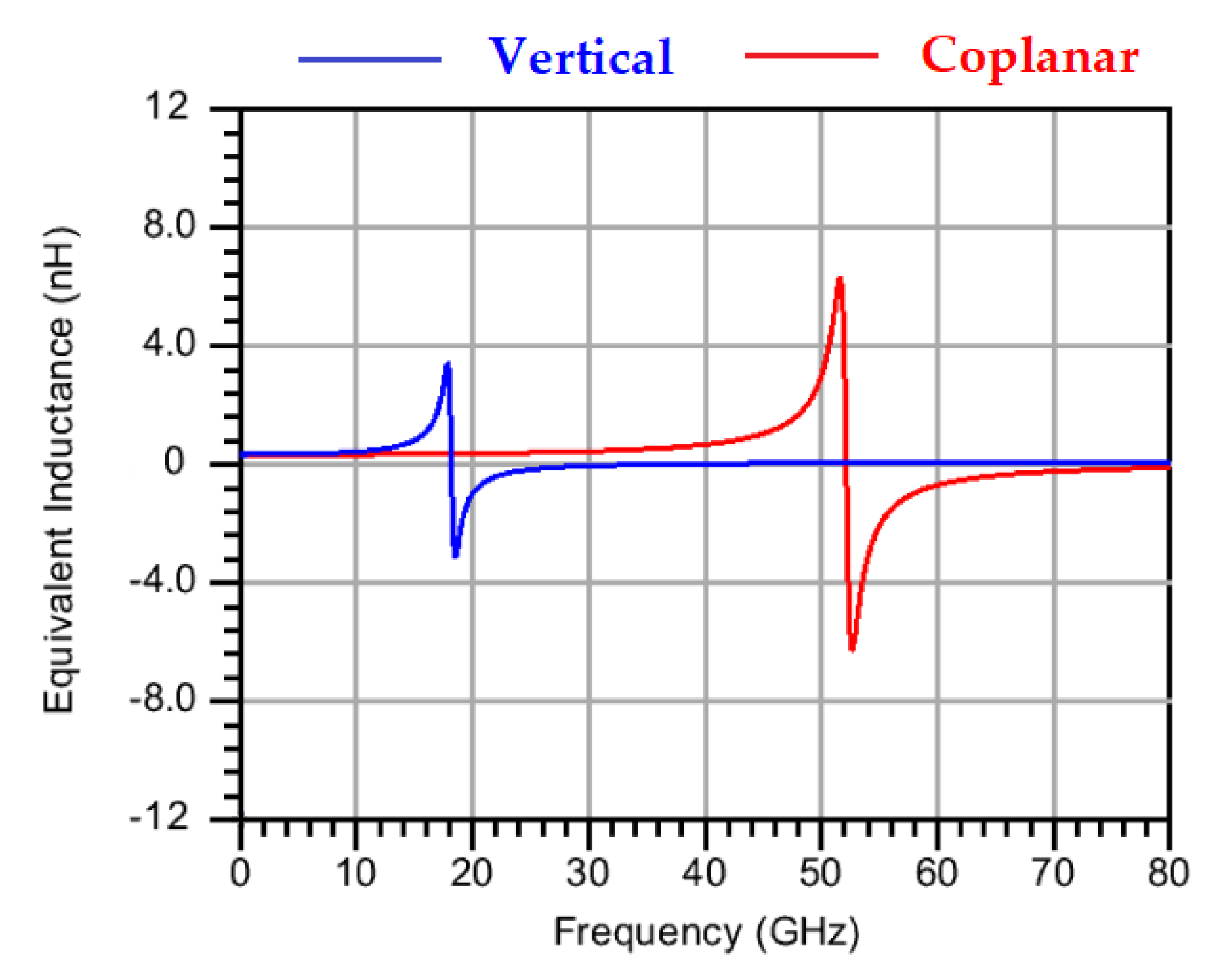

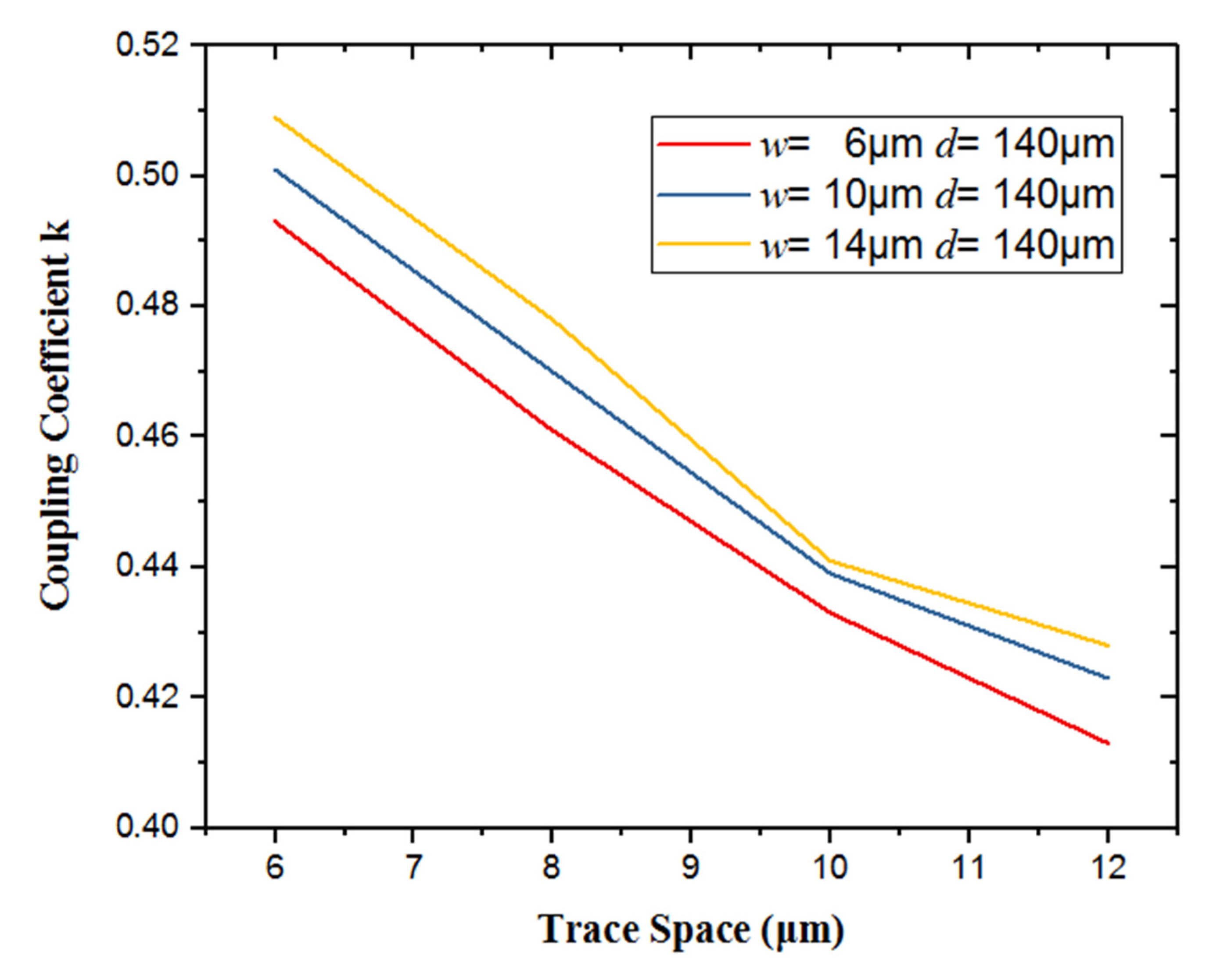
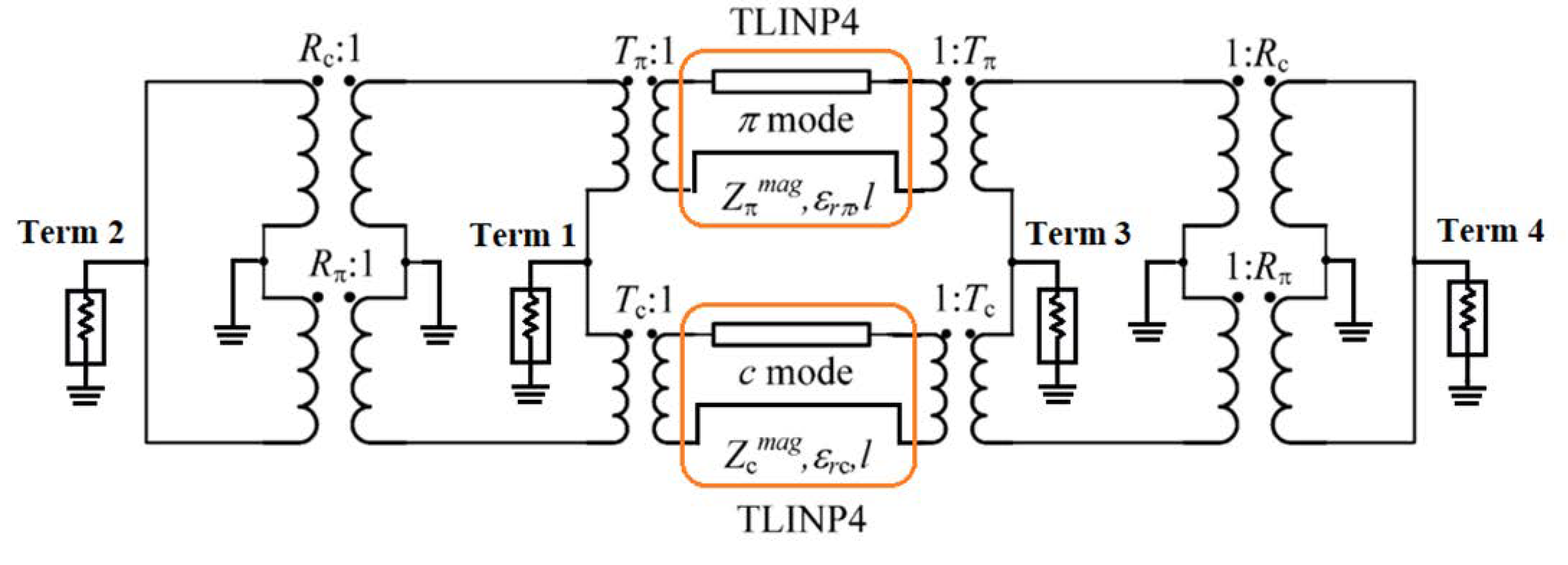
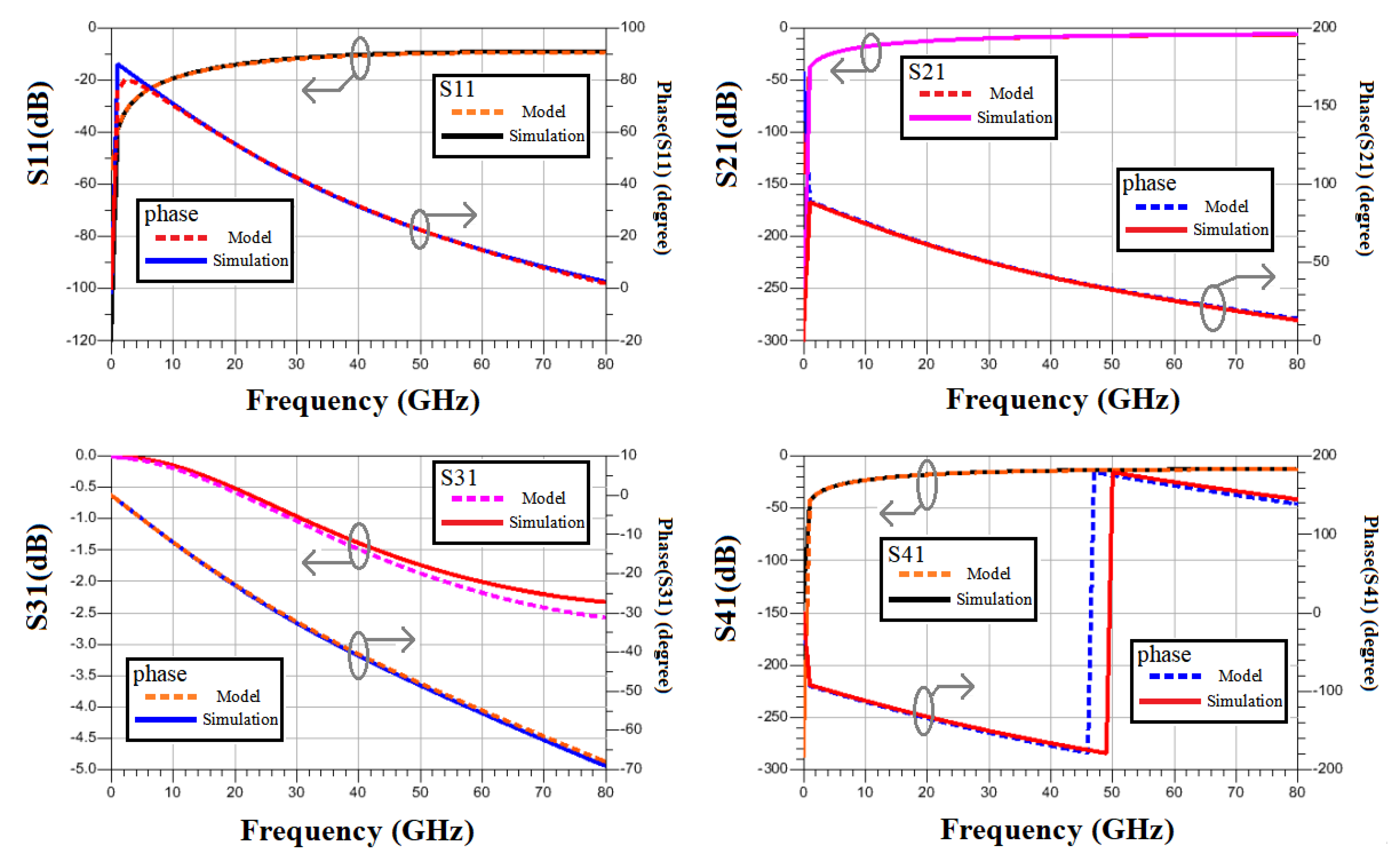
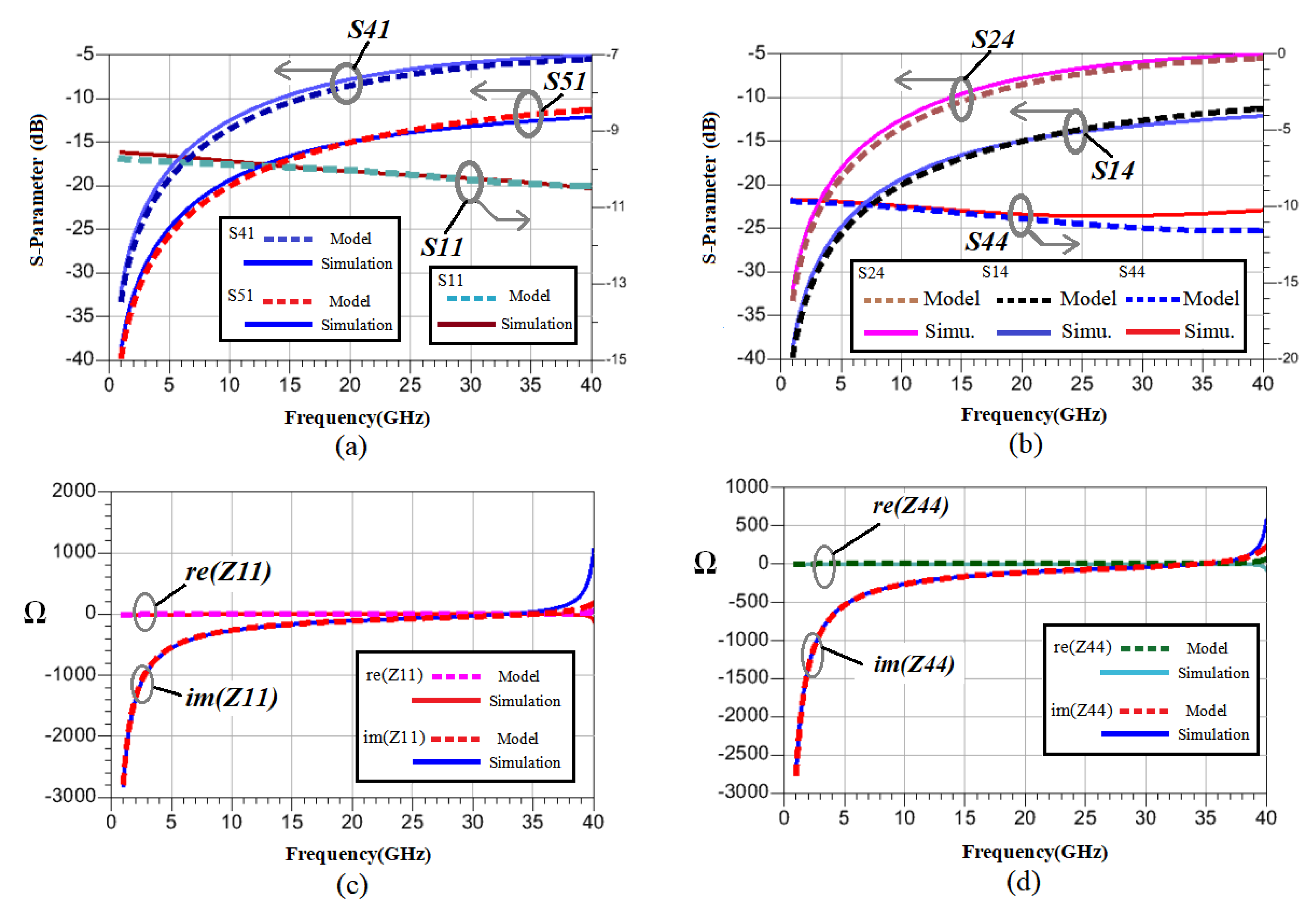
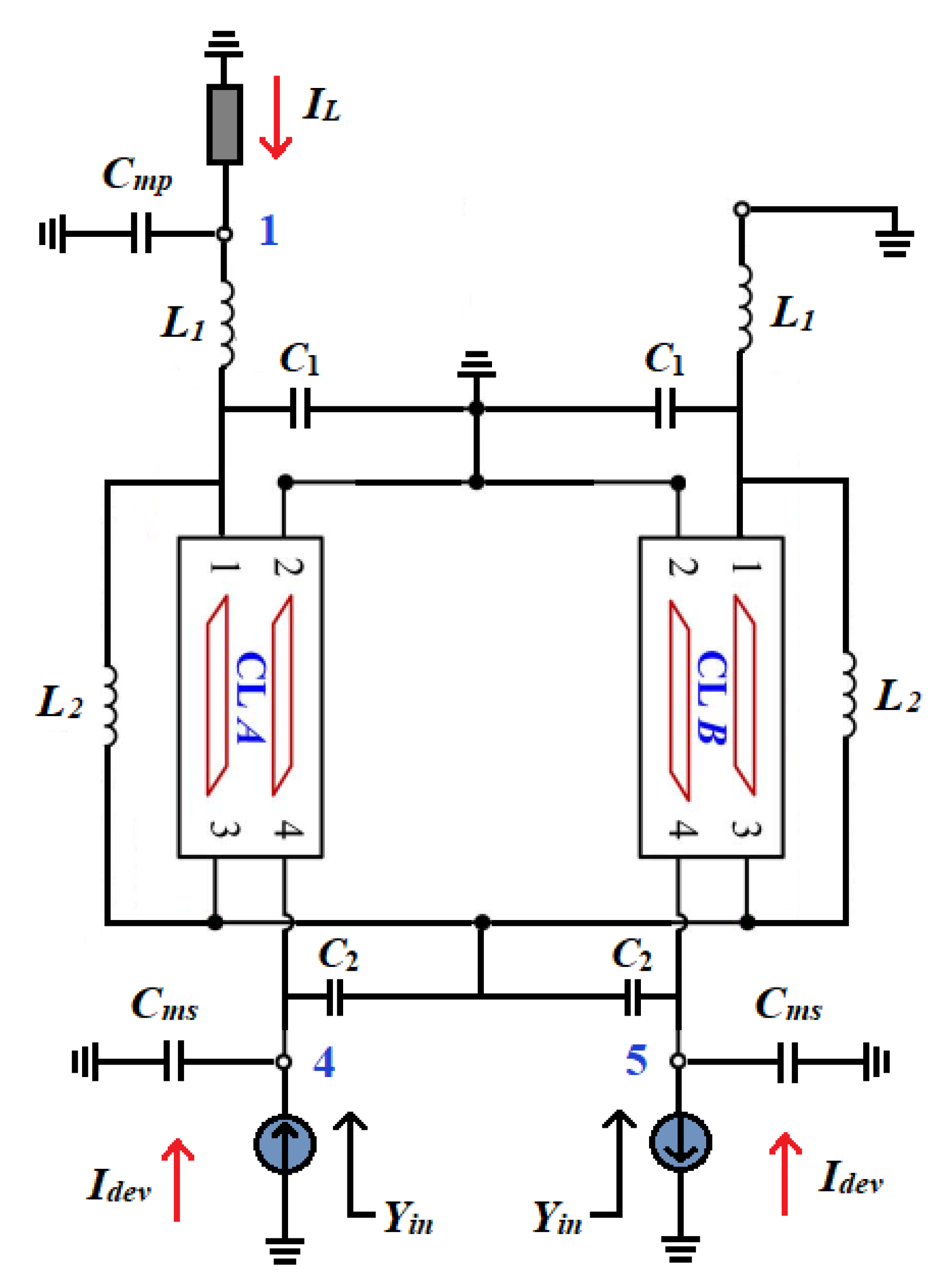
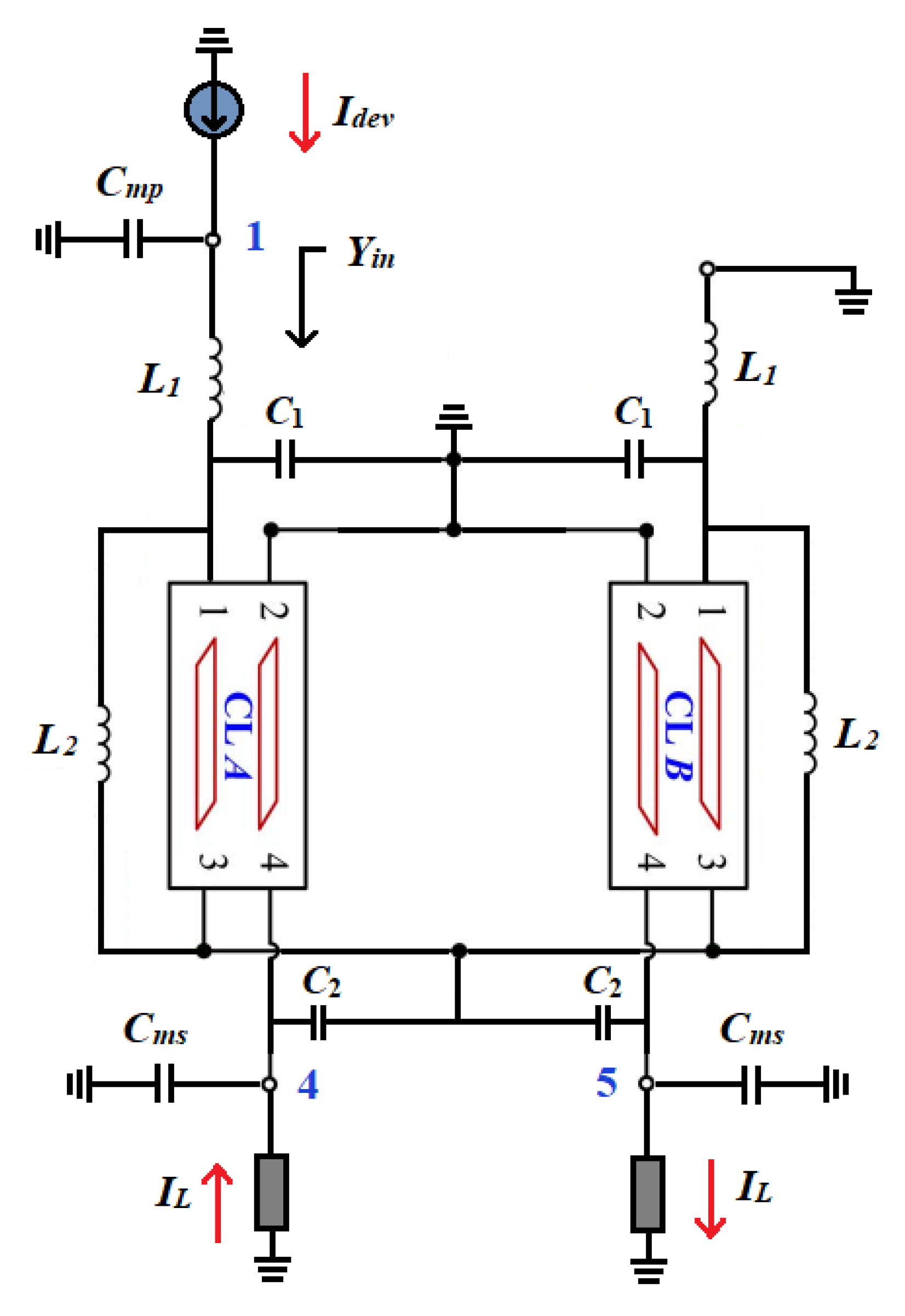
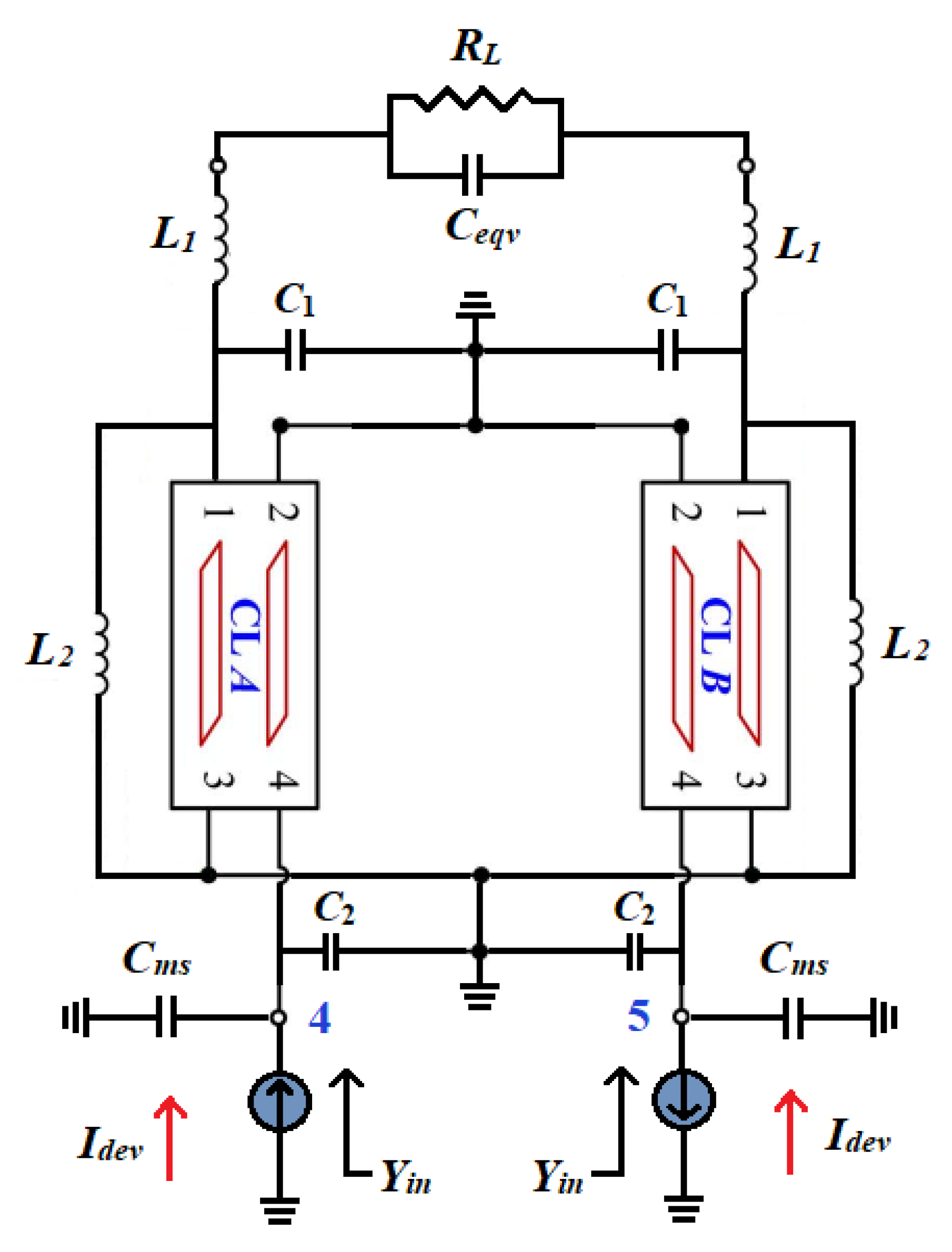
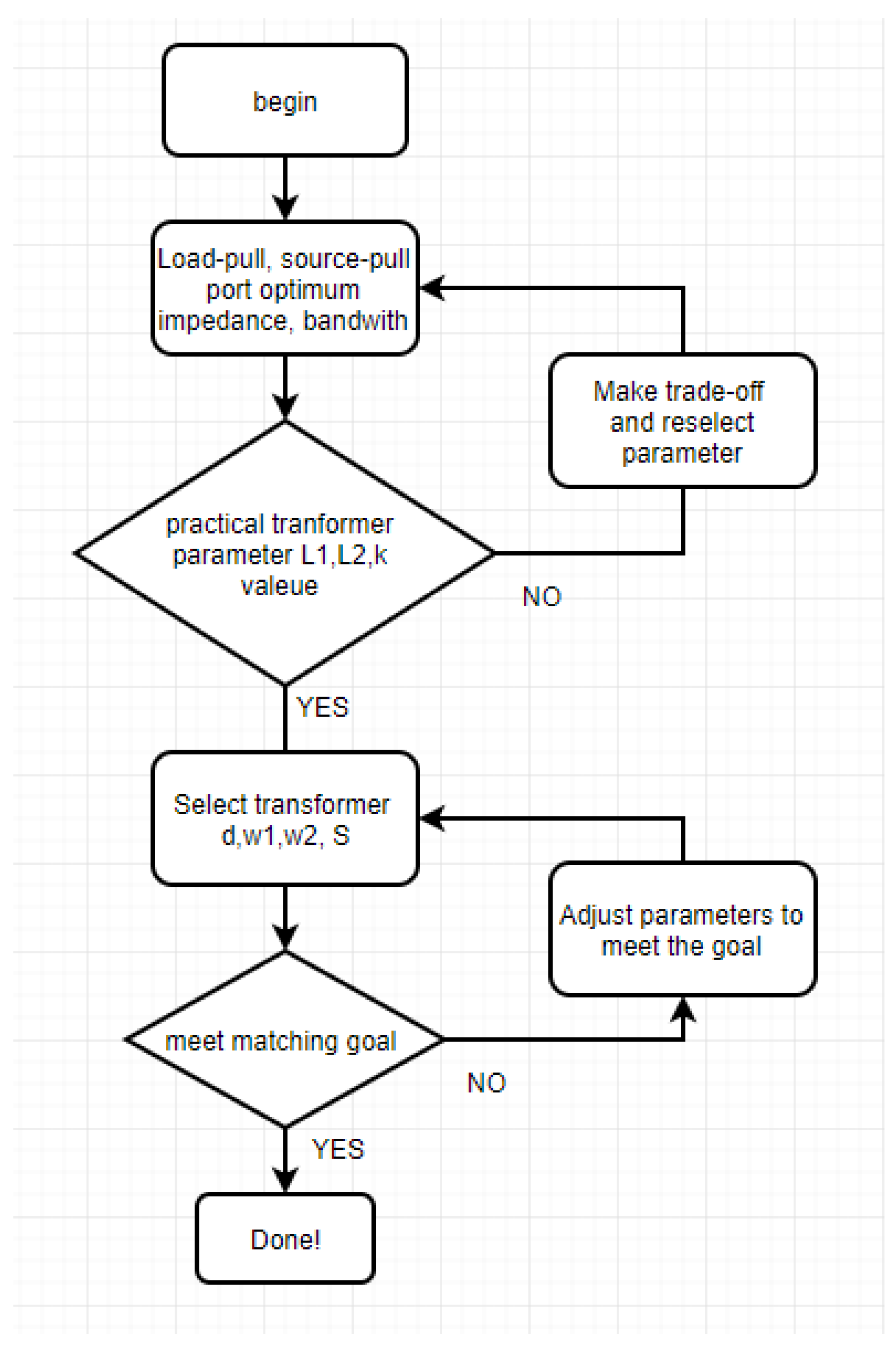
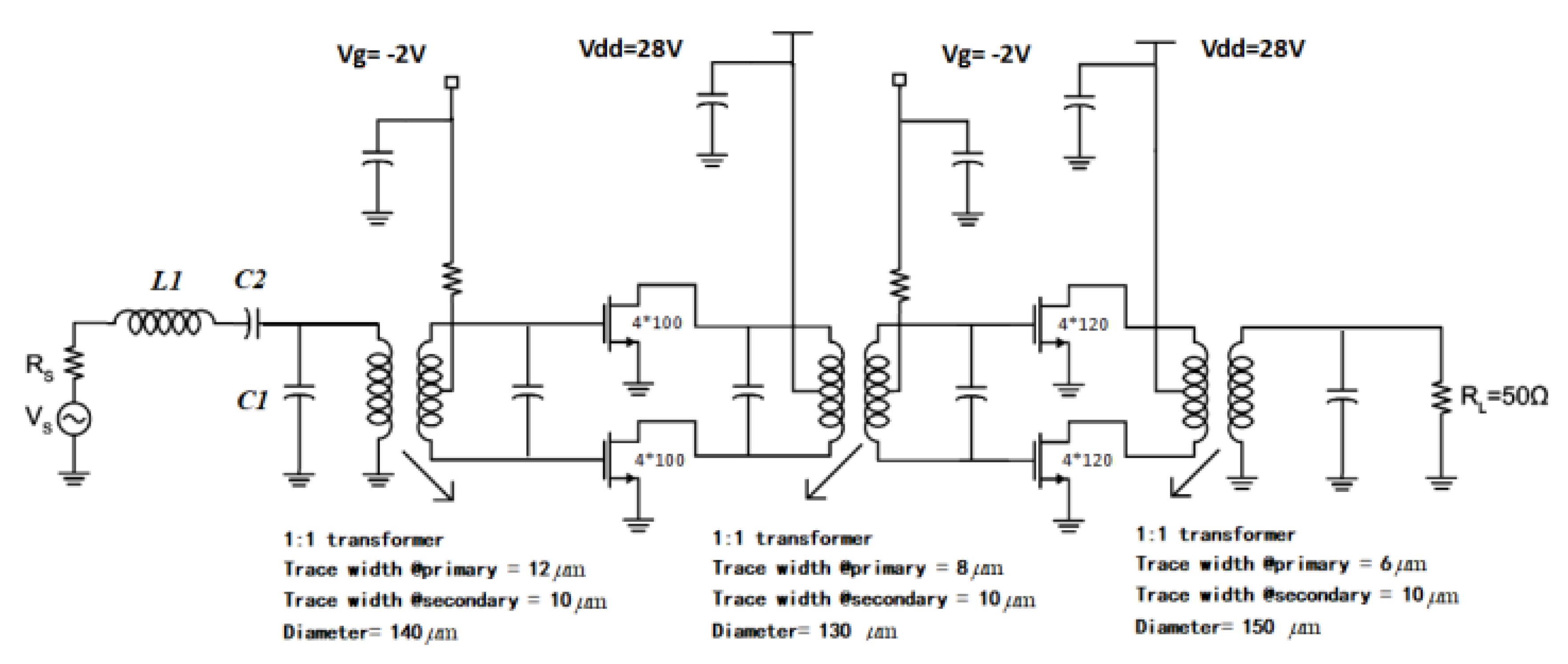

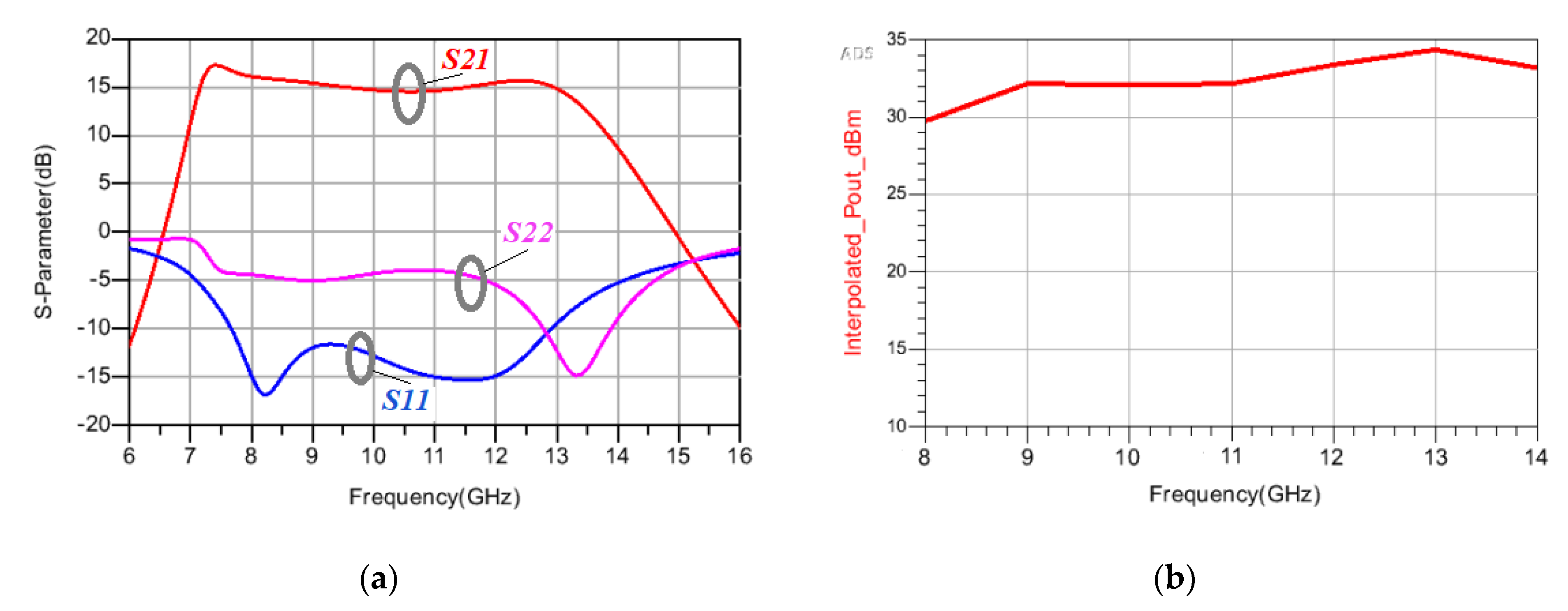
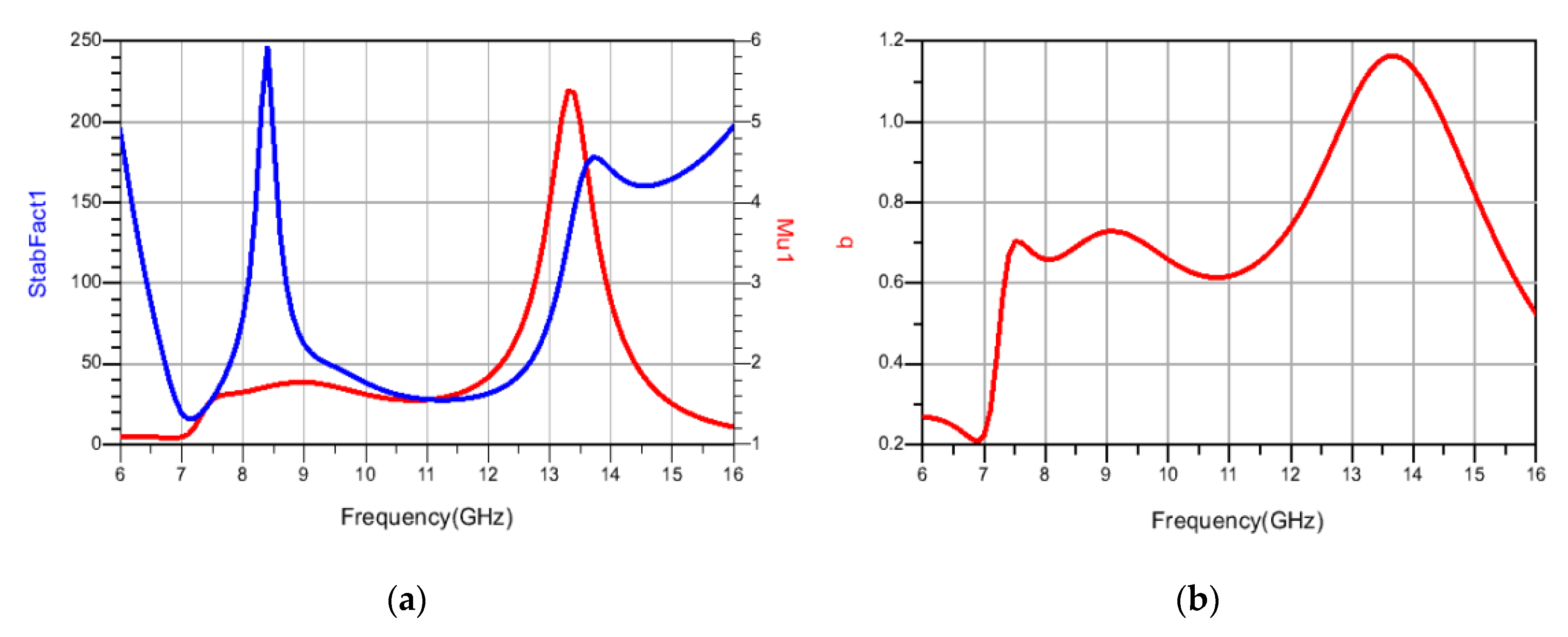
| Technology Process | TSMC 0.13 µm RF CMOS | TSMC 0.18 µm RF CMOS | TSMC 0.25 µm RF CMOS | 0.15 µm InGaAs pHEMT | 0.25 µm GaN on Sic |
|---|---|---|---|---|---|
| Number of metal layers | 8 | 6 | 5 | 2 | 2 |
| Min. metal layer space (Top thick metal) (µm) | - | 1.5 | - | 4 (MET2 scale > 50 µm) | 6 |
| Top layer Metal thickness (µm) | 3.3 | 2.34 | 0.99 | 2 | 4 |
| Top metal to substrate distance (µm) | 7.470 | 8.15 | 7.47 | 5.2 | 1.62 |
| Top metal conductance (S/m) | 5.816 × 107 | 2.464 × 107 | 2.464 × 107 | 4.1 × 107 | 4.1 × 107 |
| Substrate dielectric constant | 11.9 | 11.9 | 11.9 | 12.9 | 9.7 |
| Parameter | Value | Parameter | Value |
|---|---|---|---|
| 3.9599 | 81.0430 | ||
| 5.6313 | 416.2361 | ||
| −0.7836 + j × 0.0032 | 0.9998 − j × 0.0215 | ||
| 1.0194 + j × 0.0011 | 1 − j × 0.0015 |
| Ref. | [28] | [29] | [30] | [31] | [32] | This Work |
|---|---|---|---|---|---|---|
| Process | GaN | GaN | 0.25 µm GaN | 0.25 µm GaN | 0.25 µm GaAs | 0.25 µm GaN |
| Structure | Two-stage | Two-stage | Two-stage | Distributed | Two-stage | Two-stage |
| Matching Topology | Reactive | Reactive | Reactive | Reactive | Reactive | Transformer matching |
| Vdd (V) | 35 | 30 | 28 | 20 | 5/8 | 28 |
| Bandwidth (GHz) | 8~12 | 8.5~14 | 10~12 | 8~12 | 8.5~9.5 | 8~12 |
| Gain (dB) | 16 | - | 12~15 | 24~30 | 19.6 | 15 |
| IRL (dB) | - | - | −14 | <−11 | <−9 | <−11 |
| P1dB (dBm) | 28~29.1 | - | - | - | - | 24.54~28.16 |
| Psat (dBm) | ~32 | 34.5~38.2 | 31 | 30.5~32.5 | 28.8~29.6 | 29.64~33.05 |
| Power consumptionsat (W) | 19.51 | - | 5.49~6.71 | 8.15~11.95 | 2.03 | 10.07~14.89 |
| PAEsat (%) | 8 | - | 18~22 | 10.5~15.4 | 33.5~44.4 | 5.3~11.55 |
| Chip Size (mm2) | 6 | 6 | 4.86 | 4.67 | 4 | 1.151 |
Publisher’s Note: MDPI stays neutral with regard to jurisdictional claims in published maps and institutional affiliations. |
© 2022 by the authors. Licensee MDPI, Basel, Switzerland. This article is an open access article distributed under the terms and conditions of the Creative Commons Attribution (CC BY) license (https://creativecommons.org/licenses/by/4.0/).
Share and Cite
Fan, Y.; Wan, J.; Yang, Z.; Zhang, S.; Zhao, J.; Gao, G.; Zhang, X.; Shen, H.; Xiao, N.; Zhang, Y.; et al. Coplanar Asymmetry Transformer Distributed Modeling for X-Band Drive Power Amplifier Design on GaN Process. Electronics 2022, 11, 2478. https://doi.org/10.3390/electronics11162478
Fan Y, Wan J, Yang Z, Zhang S, Zhao J, Gao G, Zhang X, Shen H, Xiao N, Zhang Y, et al. Coplanar Asymmetry Transformer Distributed Modeling for X-Band Drive Power Amplifier Design on GaN Process. Electronics. 2022; 11(16):2478. https://doi.org/10.3390/electronics11162478
Chicago/Turabian StyleFan, Yihui, Jing Wan, Zhe Yang, Shengli Zhang, Jinxiang Zhao, Gong Gao, Xiaojie Zhang, Haoyu Shen, Nan Xiao, Yuying Zhang, and et al. 2022. "Coplanar Asymmetry Transformer Distributed Modeling for X-Band Drive Power Amplifier Design on GaN Process" Electronics 11, no. 16: 2478. https://doi.org/10.3390/electronics11162478
APA StyleFan, Y., Wan, J., Yang, Z., Zhang, S., Zhao, J., Gao, G., Zhang, X., Shen, H., Xiao, N., Zhang, Y., Yan, Y., & Liang, X. (2022). Coplanar Asymmetry Transformer Distributed Modeling for X-Band Drive Power Amplifier Design on GaN Process. Electronics, 11(16), 2478. https://doi.org/10.3390/electronics11162478






